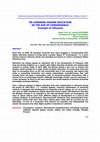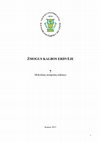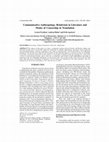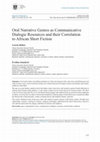Papers by Loreta Ulvydiene Huber

European Integration Studies
With the development of new technologies and rise of social media, the desire to communicate and ... more With the development of new technologies and rise of social media, the desire to communicate and share information is seen as a primary driver of social networking sites, where the aspect of self-disclosure becomes one of the key characteristics for interpersonal attraction. The aim of the research is to examine how people communicate, self-disclose and maintain relationships on social networking sites and to find out how the use of computer-mediated communication relates to relational development and maintenance. MTurk tool and social media posts were utilized to gather information. Statistical data analysis program SPSS was employed: confirmatory factor analysis (CFA) and scale analysis and construction were performed. The investigation revealed significant differences between males and females self-disclosure practices on social networking site Facebook with outstanding differences depending upon the country of living, relationship status, perceived positive and negative rewards...

Vilniaus universiteto Kauno humanitarinis fakultetas, 2013
Learning a foreign language ranks high on the priority lists of a number of people, with as many ... more Learning a foreign language ranks high on the priority lists of a number of people, with as many as 39 percent of people regretting not speaking additional languages and often wishing they could speak more languages. Yet, most learning is still restricted to devoted, goal-directed learners either through formal schooling or specialized multimedia aids. Casual learners, on the contrary, generally have lower levels of commitment and resources devoted to learning, and hence have limited means to acquire foreign languages. As intuition suggests, a top reason cited for difficulties of learning a foreign language is the “lack of time”. Considering the fact that the original purpose of films (except educational material, e.g., documentaries) is to entertain the audience, the question of whether subtitles can be used as a means of foreign language learning arises. Thus, the aim of the paper is to review and analyse the main advantages and disadvantages of film subtitling as a means of learning foreign languages. Therefore, the authors discuss subtitling in relation to foreign language learning; review the role of film translators in relation to the quality of translated films; analyse “The Da Vinci Code” - as a tool for foreign language learning and cases of non-equivalence between the source (English) and the target (Lithuanian) languages and attempt to propose alternatives for the logical mistakes made in the Lithuanian translation of “The Da Vinci Code”. Ultimately, the conclusion is drawn that subtitles are not suitable for learning single lexical units as there is no one-to-one relation between word and meaning; however, subtitles of films as a means of foreign language learning can improve skills of a person who has a command of a particular foreign language corresponding to intermediate level. Key words: subtitling, foreign language learning, audiovisual translation, subtitling techniques

Respectus Philologicus
Oral and written storytelling traditions in Africa developed at the same time and influenced each... more Oral and written storytelling traditions in Africa developed at the same time and influenced each other in many ways. In the twentieth century, the relation between the deeply rooted oral tradition and literary traditions intensified.We aim to reveal literary analysis tools that help to trace ways how oral narrative genres found reflection in African short fiction under analysis. A case study is based on two short stories by women writers, The Rain Came by Grace Ogot and The Lovers by Bessie Head. Images and symbols both, in oral and written traditions in Africa, as well as the way they evolved and extended in a literary genre of short fiction are considered within the framework of hermeneutics, reader reception theory and feminist literary criticism.The results obtained in the study prove that oral narrative genres interact with literary genres, though most importantly, women’s writing as a literary category and images embodied in the short stories play a decisive role and deviatio...

Since May of 1999, 46 European countries have been engaged in reconstructing their higher educati... more Since May of 1999, 46 European countries have been engaged in reconstructing their higher education systems to bring about a greater degree of “convergence,” i.e. a move toward common reference points and operating procedures to create a European Higher Education Area. Education has always played an important role in the development of Lithuania, with long and strong traditions as a country with highly educated scientists and cutting-edge research in various fields. In April 2009, the Seimas passed a new Law on Science and Studies, which provides for a major reform of higher education. In recent years there has been an increasing focus on the role universities play in the economy and impact they make in promoting innovation and raising international competitiveness. But until recently there has been a prescriptive view of university-business interactions with a narrow focus on technology transfer. Although technology transfer may be important, it is also necessary to focus on the mo...

Global Journal of Foreign Language Teaching, Nov 26, 2014
With the ever-increasing entertainment value of feature films and the enormous profit film indust... more With the ever-increasing entertainment value of feature films and the enormous profit film industry generates, the need to transfer them to other countries and, therefore, other languages arises. Audiovisual Translation (AVT) as a practice, thus, becomes the main medium to do so, and feature films as acts of communication are being translated in tremendous numbers. The theoretical framework of audiovisual translation, however, is only beginning to shape. Subtitling is virtually the most unique type of audiovisual translation since the message is represented in written form on screen leaving the original soundtrack/dialogue undisturbed, yet imposing time and space constraints on the written representation of the dialogue. Audiovisual translation in general and subtitling in particular are in nature semiotic processes, i.e. films (as any other audiovisual material) involve two semiotic channels – verbal and nonverbal. On the basis of this, subtitling is the only type of audiovisual translation that is intrasemiotic in nature yet involves two verbal channels different in nature, i.e. spoken and written. This implies that communication has to undergo inevitable change and reduction due to the different nature of the two verbal semiotic channels, which means that there are principles that operate in this communicative process. KEY WORDS: audiovisual translation, subtitling, semiotics, intrasemiotic translation, intercultural translation
Purpose of this study is to draw a comparative analysis between Eastern and Western cultures and ... more Purpose of this study is to draw a comparative analysis between Eastern and Western cultures and ideologies during years of Cold War within the framework of cultural anthropology, descriptive moral relativism and sociological literary criticism conducting a case study on Jack Kerouac's On the Road and its two Lithuanian translations. For the aim to be achieved the authors set the following objectives: to discuss reasons of censorship; to develop a theoretical framework for the analysis of censorship in translation and the meaning loss on the basis of Grice's conversational maxims; to carry out a comparative and statistical study highlighting censorship as reflected in the two Lithuanian translations of the chosen work. The novelty of this study rests on the fact that both older and newer translations of Kerouac's On the Road

With the ever-increasing entertainment value of feature films and the enormous profit film indust... more With the ever-increasing entertainment value of feature films and the enormous profit film industry generates, the need to transfer them to other countries and, therefore, other languages arises. Audiovisual Translation (AVT) as a practice, thus, becomes the main medium to do so, and feature films as acts of communication are being translated in tremendous numbers. The theoretical framework of audiovisual translation, however, is only beginning to shape. Subtitling is virtually the most unique type of audiovisual translation since the message is represented in written form on screen leaving the original soundtrack/dialogue undisturbed, yet imposing time and space constraints on the written representation of the dialogue. Audiovisual translation in general and subtitling in particular are in nature semiotic processes, i.e. films (as any other audiovisual material) involve two semiotic channels – verbal and nonverbal. On the basis of this, subtitling is the only type of audiovisual translation that is intrasemiotic in nature yet involves two verbal channels different in nature, i.e. spoken and written. This implies that communication has to undergo inevitable change and reduction due to the different nature of the two verbal semiotic channels, which means that there are principles that operate in this communicative process.

Studies About Languages, 2012
Translation of slang is one of the most controversial translation issues. There are no certain ru... more Translation of slang is one of the most controversial translation issues. There are no certain rules how to translate slang words and expressions, therefore, it is the translator who has to set priorities and choose the most suitable translation strategy. The aim of the paper is to reveal the effect of translation strategies employed in the translation of J. D. Salinger's The Catcher in the Rye and evaluate the success of the translation in accordance with E. A. Nida's theory of dynamic equivalence. The authors of the article discuss characteristics of slang and E. A. Nida's theory of dynamic equivalence in translation, with the main stress laid on slang translation. Further on, they group the discussed examples of slang translation according to the approved translation strategies and reveal the effect of the translation strategies employed by the translator. Most often slang words and phrases are translated by employing stylistic comepensation, literal translation and softening. In each translation strategy examples from J. D. Salinger's The Catcher in the Rye and its Lithuanian translation Rugiuose prie bedugnės by P. Gasiulis are organised according to their caused effect and further specified in terms whether each example succeeds to achieve dynamic equivalence. The authors also propose a model for slang translation.

Gricean maxims and semiotic aspects of audiovisual translation: A case study of The Iron Lady, 2014
With the ever-increasing entertainment value of feature films and the enormous profit film indust... more With the ever-increasing entertainment value of feature films and the enormous profit film industry generates, the need to transfer them to other countries and, therefore, other languages arises. Audiovisual Translation (AVT) as a practice, thus, becomes the main medium to do so, and feature films as acts of communication are being translated in tremendous numbers. The theoretical framework of audiovisual translation, however, is only beginning to shape. Subtitling is virtually the most unique type of audiovisual translation since the message is represented in written form on screen leaving the original soundtrack/dialogue undisturbed, yet imposing time and space constraints on the written representation of the dialogue. Audiovisual translation in general and subtitling in particular are in nature semiotic processes, i.e. films (as any other audiovisual material) involve two semiotic channels-verbal and nonverbal. On the basis of this, subtitling is the only type of audiovisual translation that is intrasemiotic in nature yet involves two verbal channels different in nature, i.e. spoken and written. This implies that communication has to undergo inevitable change and reduction due to the different nature of the two verbal semiotic channels, which means that there are principles that operate in this communicative process.

SUBTITLES OF FILMS AS A MEANS OF FOREIGN LANGUAGE LEARNING, 2013
Learning a foreign language ranks high on the priority lists of a number of people, with as many ... more Learning a foreign language ranks high on the priority lists of a number of people, with as many as 39 percent of people regretting not speaking additional languages and often wishing they could speak more languages. Yet, most learning is still restricted to devoted, goal-directed learners either through formal schooling or specialized multimedia aids. Casual learners, on the contrary, generally have lower levels of commitment and resources devoted to learning, and hence have limited means to acquire foreign languages. As intuition suggests, a top reason cited for difficulties of learning a foreign language is the “lack of time”.
Considering the fact that the original purpose of films (except educational material, e.g., documentaries) is to entertain the audience, the question of whether subtitles can be used as a means of foreign language learning arises. Thus, the aim of the paper is to review and analyse the main advantages and disadvantages of film subtitling as a means of learning foreign languages. Therefore, the authors discuss subtitling in relation to foreign language learning; review the role of film translators in relation to the quality of translated films; analyse “The Da Vinci Code” - as a tool for foreign language learning and cases of non-equivalence between the source (English) and the target (Lithuanian) languages and attempt to propose alternatives for the logical mistakes made in the Lithuanian translation of “The Da Vinci Code”.
Ultimately, the conclusion is drawn that subtitles are not suitable for learning single lexical units as there is no one-to-one relation between word and meaning; however, subtitles of films as a means of foreign language learning can improve skills of a person who has a command of a particular foreign language corresponding to intermediate level.
Key words: subtitling, foreign language learning, audiovisual translation, subtitling techniques

Literary Style in Translation: Slang in J. D. Salinger’s The Catcher in the Rye, 2012
Translation of slang is one of the most controversial translation issues. There are no certain ru... more Translation of slang is one of the most controversial translation issues. There are no certain rules how to translate slang words and expressions, therefore, it is the translator who has to set priorities and choose the most suitable translation strategy. The aim of the paper is to reveal the effect of translation strategies employed in the translation of J. D. Salinger's The Catcher in the Rye and evaluate the success of the translation in accordance with E. A. Nida's theory of dynamic equivalence. The authors of the article discuss characteristics of slang and E. A. Nida's theory of dynamic equivalence in translation, with the main stress laid on slang translation. Further on, they group the discussed examples of slang translation according to the approved translation strategies and reveal the effect of the translation strategies employed by the translator. Most often slang words and phrases are translated by employing stylistic comepensation, literal translation and softening. In each translation strategy examples from J. D. Salinger's The Catcher in the Rye and its Lithuanian translation Rugiuose prie bedugnės by P. Gasiulis are organised according to their caused effect and further specified in terms whether each example succeeds to achieve dynamic equivalence. The authors also propose a model for slang translation.

Communicative Anthropology, Relativism in Literature and Modes of Censorship in Translation, 2016
E-mail: 1 <Loreta.Ulvydiene@knf.vu.lt>, 2 <andreas.huber@foerderagentur.de>, 3 <agurkyte.zivile@g... more E-mail: 1 <Loreta.Ulvydiene@knf.vu.lt>, 2 <andreas.huber@foerderagentur.de>, 3 <agurkyte.zivile@gmail.com> ABSTRACT The purpose of this study is to draw a comparative analysis between Eastern and Western cultures and ideologies during years of Cold War within the framework of cultural anthropology, descriptive moral relativism and sociological literary criticism conducting a case study on Jack Kerouac's On the Road and its two Lithuanian translations. For the aim to be achieved, the researchers set the following objectives to discuss reasons of censorship, to develop a theoretical framework for the analysis of censorship in translation and the meaning loss on the basis of Grice's conversational maxims, and to carry out a comparative and statistical study highlighting censorship as reflected in the two Lithuanian translations of the chosen work. The novelty of this study rests on the fact that both, older and newer translations of Kerouac's On the Road were translated by the same translator, who was influenced by the Soviet censorship in 1972 and felt free in 2009.

Oral Narrative Genres as Communicative Dialogic Resources and their Correlation to African Short Fiction , 2020
Oral and written storytelling traditions in Africa developed at the same time and influenced each... more Oral and written storytelling traditions in Africa developed at the same time and influenced each other in many ways. In the twentieth century, the relation between the deeply rooted oral tradition and literary traditions intensified.
We aim to reveal literary analysis tools that help to trace ways how oral narrative genres found reflection in African short fiction under analysis. A case study is based on two short stories by women writers, The Rain Came by Grace Ogot and The Lovers by Bessie Head. Images and symbols both, in oral and written traditions in Africa, as well as the way they evolved and extended in a literary genre of short fiction are considered within the framework of hermeneutics, reader reception theory and feminist literary criticism.
The results obtained in the study prove that oral narrative genres interact with literary genres, though most importantly, women’s writing as a literary category and images embodied in the short stories play a decisive role and deviation from the images embodied in African oral tradition.
Keywords: genre, interpretative turn, communicative dialogic resources, short fiction, symbols.

Global Journal of Foreign Language Teaching, 2014
With the ever-increasing entertainment value of feature films and the enormous profit film indust... more With the ever-increasing entertainment value of feature films and the enormous profit film industry generates, the need to transfer them to other countries and, therefore, other languages arises. Audiovisual Translation (AVT) as a practice, thus, becomes the main medium to do so, and feature films as acts of communication are being translated in tremendous numbers. The theoretical framework of audiovisual translation, however, is only beginning to shape. Subtitling is virtually the most unique type of audiovisual translation since the message is represented in written form on screen leaving the original soundtrack/dialogue undisturbed, yet imposing time and space constraints on the written representation of the dialogue. Audiovisual translation in general and subtitling in particular are in nature semiotic processes, i.e. films (as any other audiovisual material) involve two semiotic channels-verbal and nonverbal. On the basis of this, subtitling is the only type of audiovisual translation that is intrasemiotic in nature yet involves two verbal channels different in nature, i.e. spoken and written. This implies that communication has to undergo inevitable change and reduction due to the different nature of the two verbal semiotic channels, which means that there are principles that operate in this communicative process.

The world today is characterized by an ever growing number of contacts resulting in communication... more The world today is characterized by an ever growing number of contacts resulting in communication between people with different linguistic and cultural backgrounds. This communication takes place because of contacts within the areas of business, military cooperation, science, education, mass media, entertainment, tourism but also because of immigration brought about by labor shortage or political conflicts. From the earlier times commercial interaction was one of the foremost features of ancient civilizations. Commerce of different goods by the traders created new paths of cultural interactions among different lands. Nevertheless, in the 21 st c. even the most famous business companies, e. g. General Motors, IKEA, Electrolux, etc. fail to introduce some of their products due to mistakes of inaccurate cross-cultural translation, i. e. advertising gaffes. Thus, translation is a tool for communication between diverse cultures and people of different backgrounds. This tool enables people to send and to receive information and to achieve successful communication. Besides the differences in languages there are also differences in cultures and people representing those differing cultures. The paper first gives a short overview of the concept of culture-specific items and of the techniques that are applied when translating them. Different theorists argue that cultural behavior is one of the most important aspects in translation of commercials. People from different cultures do things in different ways. Thus, I argue that it is important to increase our awareness of and sensitivity to culturally different modes of behavior. We need to recognize different cultural patterns at work in the behavior of people. It is also useful to be aware of how our own cultural background influences our behavior.
Drafts by Loreta Ulvydiene Huber

Lithuania, Latvia and Estonia are known for fights for independence and the historical memory, ye... more Lithuania, Latvia and Estonia are known for fights for independence and the historical memory, yet, few studies, if any, have been carried out about translating political events in Lithuania that was illegally occupied by the Russian army in June 1940. Two generations were born during this period of the Soviet regime and both of them became participants in Singing Revolution of January 13, 1991 that has become an important element of the Lithuanian historical memory and cultural identity. Although numerous scholars all over the world have explored the ways in which communities store their cultural memories through literature, still limited research focuses on the major role of translation to play in mediating cultural memory and cultural renewal from one time/place to another, 1 or that translations can affect the ways in which a society (re)constructs collective memory and national identity. 2. In Lithuania as well as in many other countries, films based on historical traumas have been instrumental in shaping the identity of the nation and the concept of national culture. Similarly like in Everyday Rebellion Project 3 " Emilia: Breaking Free" (2017) by Ulvydas, a drama, based on real events at the time when the word freedom and God were banned to be pronounced, speaks about the most painful period of (un)silent resistance. Subtitling that is discussed in this article is virtually the most unique type of audiovisual translation since the message is represented in written form on screen leaving the original soundtrack/dialogue undisturbed, yet imposing not only time and space constraints on the written representation of the dialogue. The semiotics of subtitling and semiotic cohesion in multimodal discourse and some of the issues that constraint this particular form of translation are considered
Conference Presentations by Loreta Ulvydiene Huber

Lithuanian and German Translations of English Songs in Selected Dubbed Films: A Comparative Analysis, 2017
Every audiovisual product is of polysemiotic nature since it is made up of the visual codes which... more Every audiovisual product is of polysemiotic nature since it is made up of the visual codes which include a wide range of elements like actors’ movements, facial expressions, body language, costumes, use of lighting, colours, etc. (Chiaro 2009) The visual codes sometimes may comprise verbal information in written form as in signposts, street signs, banners, newspapers, letters, notes,
etc. In films, visual codes are sometimes combined with the acoustic codes. The latter consist of the dialogues and of a series of non-verbal sounds such as background noises, sound effects and
music.
The study gives a brief overview of a polysemiotic structure of a film, dubbing history in Germany and in Lithuania, music-linked translation and visual synchrony. This study aims to reveal specificities of the Lithuanian and the German translations of English songs in selected dubbed films.
The analysis is grounded on the ideas of Peter Low, Peter Newmark, Frederic Chaume, Thomas Herbst, and Heike Elisabeth Jüngst and a descriptive and empirical methodology is followed in this study.
INTERMEDIA 2017: International conference on audiovisual translation, 25-26 September 2017, Poznań : book of abstracts. Poznań : Adam Mickiewicz University in Poznań. p. 46.








Uploads
Papers by Loreta Ulvydiene Huber
Considering the fact that the original purpose of films (except educational material, e.g., documentaries) is to entertain the audience, the question of whether subtitles can be used as a means of foreign language learning arises. Thus, the aim of the paper is to review and analyse the main advantages and disadvantages of film subtitling as a means of learning foreign languages. Therefore, the authors discuss subtitling in relation to foreign language learning; review the role of film translators in relation to the quality of translated films; analyse “The Da Vinci Code” - as a tool for foreign language learning and cases of non-equivalence between the source (English) and the target (Lithuanian) languages and attempt to propose alternatives for the logical mistakes made in the Lithuanian translation of “The Da Vinci Code”.
Ultimately, the conclusion is drawn that subtitles are not suitable for learning single lexical units as there is no one-to-one relation between word and meaning; however, subtitles of films as a means of foreign language learning can improve skills of a person who has a command of a particular foreign language corresponding to intermediate level.
Key words: subtitling, foreign language learning, audiovisual translation, subtitling techniques
We aim to reveal literary analysis tools that help to trace ways how oral narrative genres found reflection in African short fiction under analysis. A case study is based on two short stories by women writers, The Rain Came by Grace Ogot and The Lovers by Bessie Head. Images and symbols both, in oral and written traditions in Africa, as well as the way they evolved and extended in a literary genre of short fiction are considered within the framework of hermeneutics, reader reception theory and feminist literary criticism.
The results obtained in the study prove that oral narrative genres interact with literary genres, though most importantly, women’s writing as a literary category and images embodied in the short stories play a decisive role and deviation from the images embodied in African oral tradition.
Keywords: genre, interpretative turn, communicative dialogic resources, short fiction, symbols.
Drafts by Loreta Ulvydiene Huber
Conference Presentations by Loreta Ulvydiene Huber
etc. In films, visual codes are sometimes combined with the acoustic codes. The latter consist of the dialogues and of a series of non-verbal sounds such as background noises, sound effects and
music.
The study gives a brief overview of a polysemiotic structure of a film, dubbing history in Germany and in Lithuania, music-linked translation and visual synchrony. This study aims to reveal specificities of the Lithuanian and the German translations of English songs in selected dubbed films.
The analysis is grounded on the ideas of Peter Low, Peter Newmark, Frederic Chaume, Thomas Herbst, and Heike Elisabeth Jüngst and a descriptive and empirical methodology is followed in this study.
INTERMEDIA 2017: International conference on audiovisual translation, 25-26 September 2017, Poznań : book of abstracts. Poznań : Adam Mickiewicz University in Poznań. p. 46.
Considering the fact that the original purpose of films (except educational material, e.g., documentaries) is to entertain the audience, the question of whether subtitles can be used as a means of foreign language learning arises. Thus, the aim of the paper is to review and analyse the main advantages and disadvantages of film subtitling as a means of learning foreign languages. Therefore, the authors discuss subtitling in relation to foreign language learning; review the role of film translators in relation to the quality of translated films; analyse “The Da Vinci Code” - as a tool for foreign language learning and cases of non-equivalence between the source (English) and the target (Lithuanian) languages and attempt to propose alternatives for the logical mistakes made in the Lithuanian translation of “The Da Vinci Code”.
Ultimately, the conclusion is drawn that subtitles are not suitable for learning single lexical units as there is no one-to-one relation between word and meaning; however, subtitles of films as a means of foreign language learning can improve skills of a person who has a command of a particular foreign language corresponding to intermediate level.
Key words: subtitling, foreign language learning, audiovisual translation, subtitling techniques
We aim to reveal literary analysis tools that help to trace ways how oral narrative genres found reflection in African short fiction under analysis. A case study is based on two short stories by women writers, The Rain Came by Grace Ogot and The Lovers by Bessie Head. Images and symbols both, in oral and written traditions in Africa, as well as the way they evolved and extended in a literary genre of short fiction are considered within the framework of hermeneutics, reader reception theory and feminist literary criticism.
The results obtained in the study prove that oral narrative genres interact with literary genres, though most importantly, women’s writing as a literary category and images embodied in the short stories play a decisive role and deviation from the images embodied in African oral tradition.
Keywords: genre, interpretative turn, communicative dialogic resources, short fiction, symbols.
etc. In films, visual codes are sometimes combined with the acoustic codes. The latter consist of the dialogues and of a series of non-verbal sounds such as background noises, sound effects and
music.
The study gives a brief overview of a polysemiotic structure of a film, dubbing history in Germany and in Lithuania, music-linked translation and visual synchrony. This study aims to reveal specificities of the Lithuanian and the German translations of English songs in selected dubbed films.
The analysis is grounded on the ideas of Peter Low, Peter Newmark, Frederic Chaume, Thomas Herbst, and Heike Elisabeth Jüngst and a descriptive and empirical methodology is followed in this study.
INTERMEDIA 2017: International conference on audiovisual translation, 25-26 September 2017, Poznań : book of abstracts. Poznań : Adam Mickiewicz University in Poznań. p. 46.